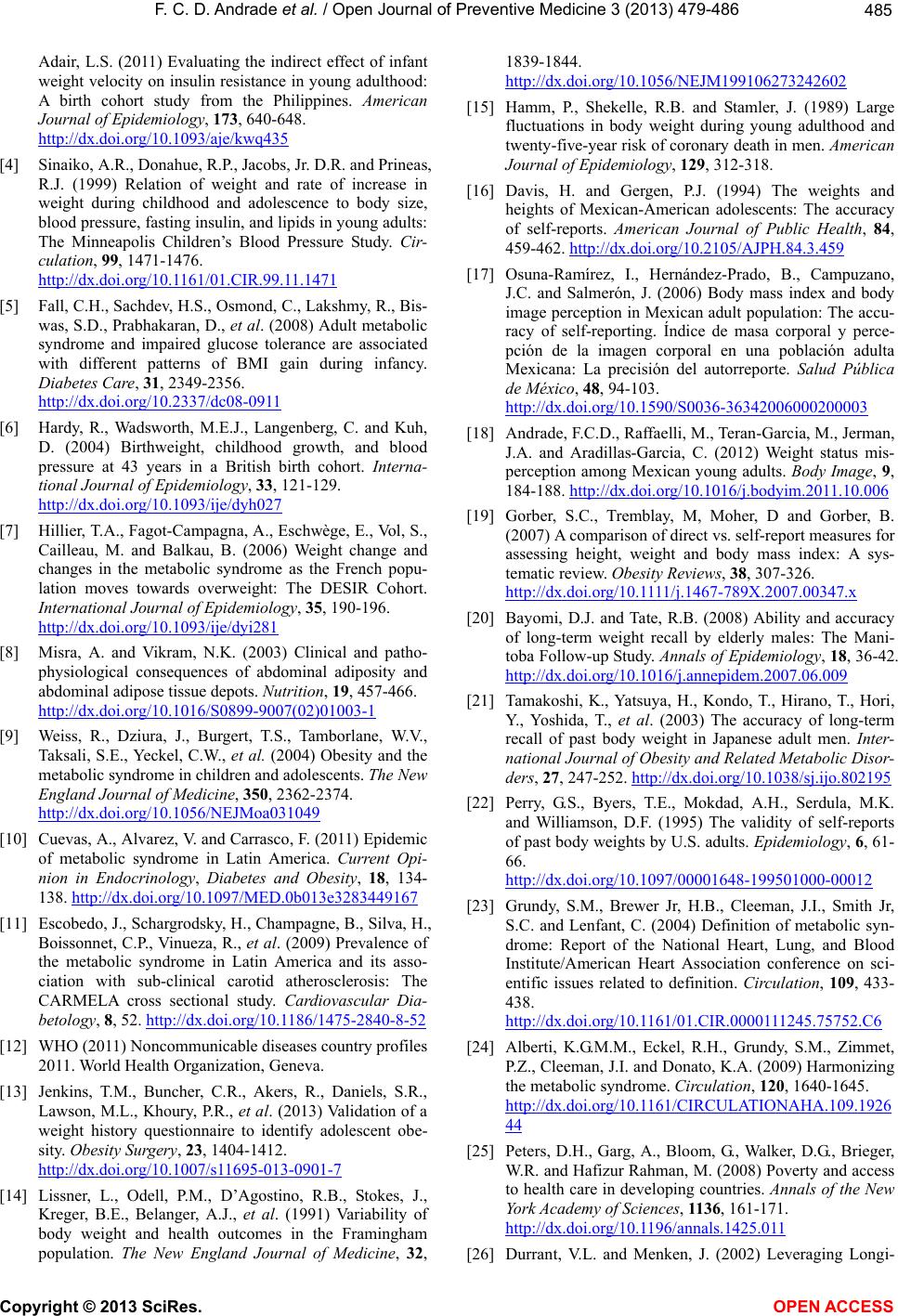
F. C. D. Andrade et al. / Open Journal of Preventive Medicine 3 (2013) 479-486 485
Adair, L.S. (2011) Evaluating the indirect effect of infant
weight velocity on insulin resistance in young adulthood:
A birth cohort study from the Philippines. American
Journal of Epidemiology, 173, 640-648.
http://dx.doi.org/10.1093/aje/kwq435
[4] Sinaiko, A.R., Donahue, R.P., Jacobs, Jr. D.R. and Prineas,
R.J. (1999) Relation of weight and rate of increase in
weight during childhood and adolescence to body size,
blood pressure, fasting insulin, and lipids in young adults:
The Minneapolis Children’s Blood Pressure Study. Cir-
culation, 99, 1471-1476.
http://dx.doi.org/10.1161/01.CIR.99.11.1471
[5] Fall, C.H., Sachdev, H.S., Osmond, C., Lakshmy, R., Bis-
was, S.D., Prabhakaran, D., et al. (2008) Adult metabolic
syndrome and impaired glucose tolerance are associated
with different patterns of BMI gain during infancy.
Diabetes Care, 31, 2349-2356.
http://dx.doi.org/10.2337/dc08-0911
[6] Hardy, R., Wadsworth, M.E.J., Langenberg, C. and Kuh,
D. (2004) Birthweight, childhood growth, and blood
pressure at 43 years in a British birth cohort. Interna-
tional Journal of Epidemiology, 33, 121-129.
http://dx.doi.org/10.1093/ije/dyh027
[7] Hillier, T.A., Fagot-Campagna, A., Eschwège, E., Vol, S.,
Cailleau, M. and Balkau, B. (2006) Weight change and
changes in the metabolic syndrome as the French popu-
lation moves towards overweight: The DESIR Cohort.
International Journal of Epidemiology, 35, 190-196.
http://dx.doi.org/10.1093/ije/dyi281
[8] Misra, A. and Vikram, N.K. (2003) Clinical and patho-
physiological consequences of abdominal adiposity and
abdominal adipose tissue depots. Nutrition, 19, 457-466.
http://dx.doi.org/10.1016/S0899-9007(02)01003-1
[9] Weiss, R., Dziura, J., Burgert, T.S., Tamborlane, W.V.,
Taksali, S.E., Yeckel, C.W., et al. (2004) Obesity and the
metabolic syndrome in children and adolescents. The New
England Journal of Medicine, 350, 2362-2374.
http://dx.doi.org/10.1056/NEJMoa031049
[10] Cuevas, A., Alvarez, V. and Carrasco, F. (2011) Epidemic
of metabolic syndrome in Latin America. Current Opi-
nion in Endocrinology, Diabetes and Obesity, 18, 134-
138. http://dx.doi.org/10.1097/MED.0b013e3283449167
[11] Escobedo, J., Schargrodsky, H., Champagne, B., Silva, H.,
Boissonnet, C.P., Vinueza, R., et al. (2009) Prevalence of
the metabolic syndrome in Latin America and its asso-
ciation with sub-clinical carotid atherosclerosis: The
CARMELA cross sectional study. Cardiovascular Dia-
betology, 8, 52. http://dx.doi.org/10.1186/1475-2840-8-52
[12] WHO (2011) Noncommunicable diseases country profiles
2011. World Health Organization, Geneva.
[13] Jenkins, T.M., Buncher, C.R., Akers, R., Daniels, S.R.,
Lawson, M.L., Khoury, P.R., et al. (2013) Validation of a
weight history questionnaire to identify adolescent obe-
sity. Obesity Surgery, 23, 1404-1412.
http://dx.doi.org/10.1007/s11695-013-0901-7
[14] Lissner, L., Odell, P.M., D’Agostino, R.B., Stokes, J.,
Kreger, B.E., Belanger, A.J., et al. (1991) Variability of
body weight and health outcomes in the Framingham
population. The New England Journal of Medicine, 32,
1839-1844.
http://dx.doi.org/10.1056/NEJM199106273242602
[15] Hamm, P., Shekelle, R.B. and Stamler, J. (1989) Large
fluctuations in body weight during young adulthood and
twenty-five-year risk of coronary death in men. American
Journal of Epidemiology, 129, 312-318.
[16] Davis, H. and Gergen, P.J. (1994) The weights and
heights of Mexican-American adolescents: The accuracy
of self-reports. American Journal of Public Health, 84,
459-462. http://dx.doi.org/10.2105/AJPH.84.3.459
[17] Osuna-Ramírez, I., Hernández-Prado, B., Campuzano,
J.C. and Salmerón, J. (2006) Body mass index and body
image perception in Mexican adult population: The accu-
racy of self-reporting. Índice de masa corporal y perce-
pción de la imagen corporal en una población adulta
Mexicana: La precisión del autorreporte. Salud Pública
de México, 48, 94-103.
http://dx.doi.org/10.1590/S0036-36342006000200003
[18] Andrade, F.C.D., Raffaelli, M., Teran-Garcia, M., Jerman,
J.A. and Aradillas-Garcia, C. (2012) Weight status mis-
perception among Mexican young adults. Body Image, 9,
184-188. http://dx.doi.org/10.1016/j.bodyim.2011.10.006
[19] Gorber, S.C., Tremblay, M, Moher, D and Gorber, B.
(2007) A comparison of direct vs. self-report measures for
assessing height, weight and body mass index: A sys-
tematic review. Obesity Revi ews, 38, 307-326.
http://dx.doi.org/10.1111/j.1467-789X.2007.00347.x
[20] Bayomi, D.J. and Tate, R.B. (2008) Ability and accuracy
of long-term weight recall by elderly males: The Mani-
toba Follow-up Study. Annals of Epidemiology, 18, 36-42.
http://dx.doi.org/10.1016/j.annepidem.2007.06.009
[21] Tamakoshi, K., Yatsuya, H., Kondo, T., Hirano, T., Hori,
Y., Yoshida, T., et al. (2003) The accuracy of long-term
recall of past body weight in Japanese adult men. Inter-
national Journal of Obesity and Related Metabolic Disor-
ders, 27, 247-252. http://dx.doi.org/10.1038/sj.ijo.802195
[22] Perry, G.S., Byers, T.E., Mokdad, A.H., Serdula, M.K.
and Williamson, D.F. (1995) The validity of self-reports
of past body weights by U.S. adults. Epidemiology, 6, 61-
66.
http://dx.doi.org/10.1097/00001648-199501000-00012
[23] Grundy, S.M., Brewer Jr, H.B., Cleeman, J.I., Smith Jr,
S.C. and Lenfant, C. (2004) Definition of metabolic syn-
drome: Report of the National Heart, Lung, and Blood
Institute/American Heart Association conference on sci-
entific issues related to definition. Circulation, 109, 433-
438.
http://dx.doi.org/10.1161/01.CIR.0000111245.75752.C6
[24] Alberti, K.G.M.M., Eckel, R.H., Grundy, S.M., Zimmet,
P.Z., Cleeman, J.I. and Donato, K.A. (2009) Harmonizing
the metabolic syndrome. Circulation, 120, 1640-1645.
http://dx.doi.org/10.1161/CIRCULATIONAHA.109.1926
44
[25] Peters, D.H., Garg, A., Bloom, G., Walker, D.G., Brieger,
W.R. and Hafizur Rahman, M. (2008) Poverty and access
to health care in developing countries. Annals of the New
York Academy of Sciences, 1136, 161-171.
http://dx.doi.org/10.1196/annals.1425.011
[26] Durrant, V.L. and Menken, J. (2002) Leveraging Longi-
Copyright © 2013 SciRes. OPEN A CCESS